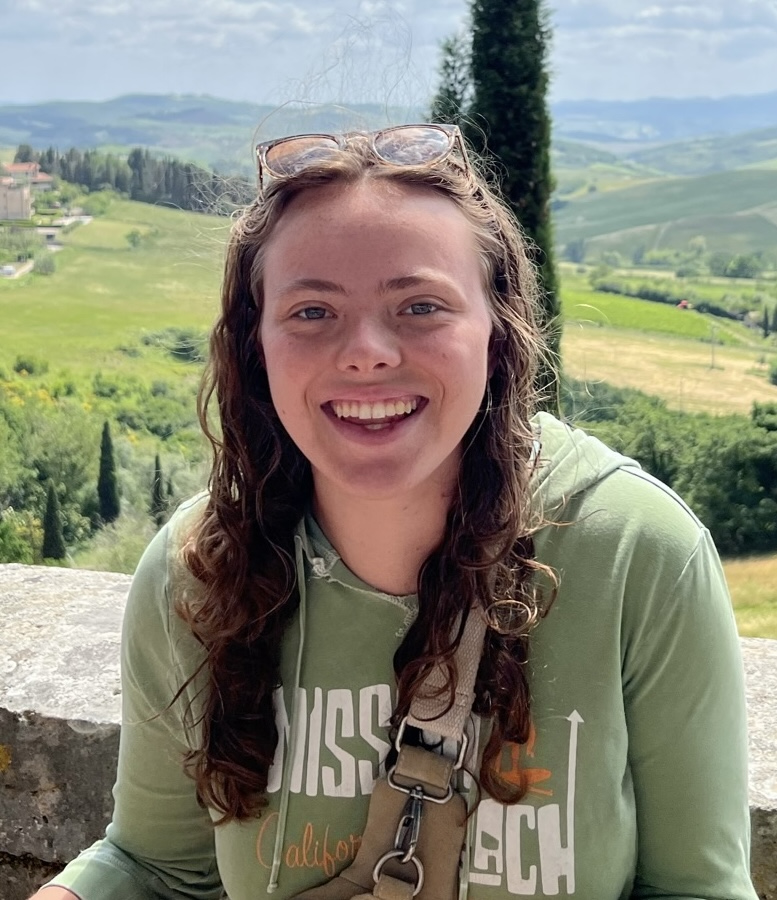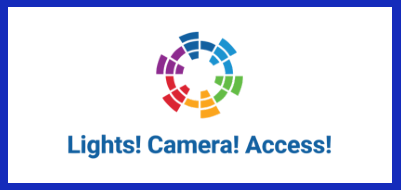
Intern Writer, Maddie Jones
[Images Description: A Caucasian woman (Maddie Jones) wears a sweatshirt, glasses, and a strapped purse that sits across her chest. Behind Maddie is an open outdoor scenery.]
I have been physically disabled my whole life. I am the spitting image of disability – the literal disability symbol: a white person in a wheelchair – and it filters how I see the world. Whether I realized it at the time or not, a lot of how I spend my time, what I’ve studied and chosen to do for work comes back to figuring out the dichotomy that comes with living with a disability and my role in improving conditions in the world for people with disabilities at large.
Raised in the Philadelphia suburbs, I first got involved in disability and entertainment as an actor in a local acting troupe for people with physical disabilities and worked on a few independent film projects – being authentically cast as a child with cerebral palsy. As I got older, my performative side turned into public speaking and writing about my lived experience. However, I was also mainstreamed in school for my entire life and became comfortable being the only one in the room with a visible physical disability. As the sole physical disability representation in most rooms, it has also meant that my presence in a space often forces the space to become more accessible. In advocating for myself, I have been advocating for disability issues my whole life.
Hearing that, people have asked me what ableist moments motivate me to work in the disability space. While ableism comes with the territory, it is not what motivates me to advocate and write. Instead, the community has pushed me to work in this field. It started in adaptive sports in high school. My wheelchair basketball team was the definition of diversity. Our team was made up from all walks of life. Name another identity that someone could hold, and it was most likely held by someone on my team or their family. I realized disability can be a unifying factor for people with vastly different lives and yet those differing experiences can lead to dramatically different realities as a disabled person. We have a lot of work to do. I want to help my friends have easier lives and, in the process, help myself. As a white woman, if I’m ever the definition of diversity, there’s something wrong and I quickly realized I needed to intentionally seek out disability communities and experiences similar and different to my own. As I have continued to learn, people’s variety of experiences has broadened my desire to get involved in disability issues and that advocating for people with disabilities means working on climate change, improving public resources, and changing education systems. Disability requires one to think intersectionally and that is what I attempt to do in my work.
However, for most of college, I avoided the disability classes. I didn’t want to enter those classes and as a disabled student must be the representation of the disabled experience. In my senior year, a disabled teacher decided to teach a crip theory class and for the first time in my life, he gave me the freedom to learn about disability and the academic thinking around it. I didn’t need to pretend to be the knowledgeable one in the room. I could ask questions and complicate my understanding of disability beyond my lived experience. Unsurprisingly, all the other disabled students on campus took his class and together we advanced our thinking.
It is from these spaces of community that I gained the skills, knowledge, and passion to write about disability. Advocacy work seeped into my interests in education. I graduated from Pomona College in Claremont, CA with a degree in Philosophy, Politics, and Economics (PPE). I also was working toward minors in Chemistry, Film, and Classics, but I graduated early.
When I first was figuring out what I wanted to do as a career, as a CP kid, I thought it would be in neuroscience, so I worked at a neuro gene therapy lab. However, I quickly realized that while the puzzle of gene therapy is fascinating, slicing mouse organs in a dark room by yourself is not for me. I also didn’t want to focus my disability work through a medical model lens. I tried a few other things and then landed on community organizing specifically around disability issues.
During my senior year, I realized that I could combine my passion for disability advocacy and love of film into a career and began studying disability film theory and the impact of representation on screen. Stories are the fundamental building blocks of society and if we want to see significant change for the disability community, we must start by influencing the stories we tell and see. After a fellowship with RespectAbility, I have become a freelance disability consultant and continue advocating and writing about disability in a variety of spaces. My long-term goal is to start a production company called Wait…What? Whoa!
Simultaneously, I hope to continue exploring disability in the Lights! Camera! Access! community. While writing for LCA, I will seize the opportunity to research and write about topics that complicate people’s understanding and thinking about disability (and most likely my own). For allies of the disabled community, I want to motivate them to think about their relationship with disability and to take action. It can’t always be disabled people’s responsibility to advocate. For disabled people, I hope to create moments of realization and being seen. It is from those rare circumstances that people can expand their thinking around what is possible and chase their dreams.
More specifically, here’s what I bring to the table as a journalist: to quote the great late Judy Heumann, “Nothing about us, without us.” It is important to hear from me because I am part of the disability community and have been my entire life. However, I am only one of the many voices you should hear when it comes to disability (aka please read the other wonderful LCA writers). I spent most of my life not in disabled spaces and it is only in adulthood that I’ve chosen a career that allows me to interact with people with disabilities regularly. Being comfortable in non-disabled spaces hopefully gives me the ability to meet people where they are, whether that’s being a longtime ally or disabled person and wanting to discuss the nuances of Alison Kafer’s political-relational model of disability or they’ve never met a person with a physical disability and have a lot of questions. Also, since I acquired my disability at birth, in answering questions about how I became disabled and my overall disabled experience, I’m not asked to relive a traumatic moment in my life. I don’t know anything else but being disabled. This is not always the case, so please don’t casually ask people about their disabilities, but if you have questions, please feel free to reach out to LCA for my information. While I love writing about disability-related topics, I always love to connect through dialogue — after all the basis of the Americans with Disabilities Act is creating a space for conversation.
My relationship with disability continues to evolve and I hope always does. While most people gain a relationship with disability as they age, hopefully, at some point as I age my disability will no longer make me stand out, but make me fit in with the crowd. That’s why I always say “Disability isn’t just a good idea; it’s inevitable”
